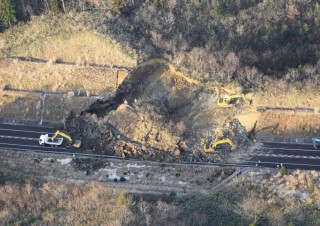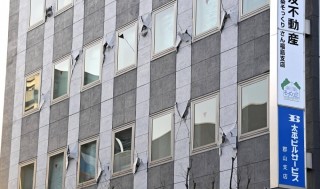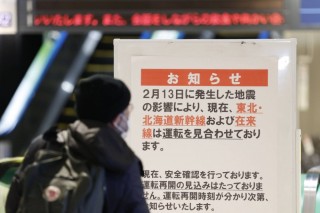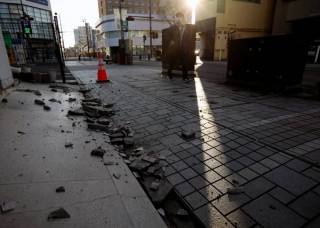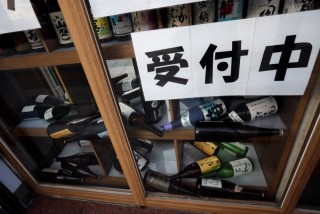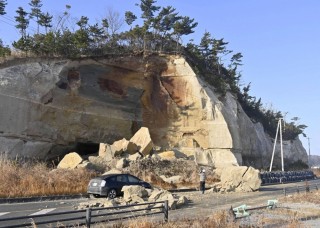Loading
Search
▼ Japan Scrambles To Assess Damage After Quake Wreaks Havoc In Tohoku
- Category:Other
The government on Sunday scrambled to gather information after an earthquake with a preliminary magnitude of 7.3 struck off northeastern Japan late the previous night, leaving 150 people injured and causing widespread blackouts.
No tsunami accompanied the quake that struck at 11:07 p.m. Saturday and no issues were found at nuclear power plants in the affected region. There have been no deaths reported.
Widespread blackouts, which affected at least 950,000 households at one point, were largely resolved by the morning with the exception of several hundred homes in Fukushima Prefecture.
Many houses and buildings were damaged and at least 240 people in Miyagi and Fukushima prefectures temporarily took shelter at evacuation centers. In Fukushima, around 70 evacuation centers have been set up and 203 people were taking shelter, according to the prefectural government. At the request of Fukushima Prefecture, the Ground Self-Defense Force began supplying water to residents in the town of Shinchi, which suffered disruptions to its water supplies in most areas.
Miyagi Prefecture also continued to experience water supply issues, with about 5,000 households there experiencing supply cuts.
Defense Minister Nobuo Kishi had earlier directed the Self-Defense Forces to gather information on the scope of the damage and be prepared to respond immediately. The Meteorological Agency is urging caution due to the potential for landslides, as a storm warning has been issued for much of the Kanto and Tohoku regions for Monday.
The earthquake registered a strong 6 on the Japanese seismic intensity scale to 7 in parts of Miyagi and Fukushima prefectures. It also jolted Tokyo, where it registered a 4 on the Japanese scale, and was the strongest to hit the region since April 7, 2011, the Meteorology Agency said. The epicenter was off the coast of Fukushima, about 220 kilometers (135 miles) north of the capital. Its focus was estimated to be at a depth of about 55 kilometers.
More than 150 people were injured in Miyagi, Yamagata, Fukushima, Ibaraki, Tochigi, Gunma, Saitama, Chiba and Kanagawa prefectures. Chief Cabinet Secretary Katsunobu Kato said two people in Fukushima and one person in Saitama had serious injuries.
Cabinet ministers met in the morning and were updated on the extent of damage caused by the quake, which affected areas devastated by the catastrophic magnitude 9.0 quake and tsunami almost 10 years ago that triggered nuclear meltdowns. Prime Minister Yoshihide Suga said during the Cabinet meeting that no deaths had been reported, but urged vigilance amid the prospect of continued aftershocks up to a strong 6 on the Japanese scale.
“We urge the people in the affected areas to continuously pay attention to information from entities such as municipalities, be on alert and be ready to act fast and consider weather changes after tomorrow,” Suga said.
At a news conference early Sunday morning, a Meteorological Agency official said aftershocks of up to a strong 6 on the Japanese scale could occur for at least a week. The official said Saturday’s quake was believed to be an aftershock of the Great East Japan Earthquake that struck the same region on March 11, 2011.
“Because (the 2011 quake) was an enormous one with a magnitude of 9.0, it’s not surprising to have an aftershock of this scale 10 years later,” said Kenji Satake, a professor at the University of Tokyo’s Earthquake Research Institute. The quake registered a strong 6 in the southern part of Miyagi, and in the Nakadori central and Hamadori coastal regions of Fukushima, the Meteorological Agency said.
No abnormalities had initially been detected at the Fukushima Nos. 1 and 2 nuclear power plants, according to Tokyo Electric Power, but water at the spent fuel pools of the No. 1 plant’s reactors 5 and 6 buildings had partially spilled over. The spillage was limited to inside the buildings.
Meanwhile, Japan Atomic Power Co.’s inactive Tokai No. 2 nuclear power plant in the village of Tokai in Ibaraki Prefecture and Tohoku Electric Power Co.’s Onagawa nuclear plant in Miyagi Prefecture both reported no abnormalities, according to their operators.
East Japan Railway Co. said Tohoku Shinkansen services between Nasushiobara Station in Tochigi Prefecture and Morioka Station in Iwate Prefecture have been suspended and will remain out of service at least until the end of Monday after poles in several locations from which overhead wires are suspended were bent due to the quake. The resumption of regular services will take about 10 days due to repair work, the company said. Yamagata Shinkansen services between Tokyo and Shinjo stations, as well as Akita Shinkansen services between Tokyo and Akita stations, will also remain suspended through Monday.
A landslide covered a section of the Joban Expressway in Soma, Fukushima Prefecture, officials said, but no vehicles were found to be trapped. Heavy equipment had been dispatched to remove large boulders and soil, which blocked all lanes.
Horizontal shaking lasted for a few minutes, bringing back memories of the 2011 megaquake for many.
“The initial jolt felt more powerful than the one I experienced in the Great East Japan Earthquake,” said Tomoko Kobayashi, 68, who works at an inn in Minamisoma, Fukushima Prefecture, where plates were scattered around the dining room. “I wondered if it would end.”
After the 7.3 quake, many smaller earthquakes with magnitudes between 3 and 5 occurred off Fukushima. The Meteorological Agency said the quake was felt in wide areas of Japan, as far north as Hokkaido and as far west as the Chugoku region, which includes Hiroshima.
No tsunami accompanied the quake that struck at 11:07 p.m. Saturday and no issues were found at nuclear power plants in the affected region. There have been no deaths reported.
Widespread blackouts, which affected at least 950,000 households at one point, were largely resolved by the morning with the exception of several hundred homes in Fukushima Prefecture.
Many houses and buildings were damaged and at least 240 people in Miyagi and Fukushima prefectures temporarily took shelter at evacuation centers. In Fukushima, around 70 evacuation centers have been set up and 203 people were taking shelter, according to the prefectural government. At the request of Fukushima Prefecture, the Ground Self-Defense Force began supplying water to residents in the town of Shinchi, which suffered disruptions to its water supplies in most areas.
Miyagi Prefecture also continued to experience water supply issues, with about 5,000 households there experiencing supply cuts.
Defense Minister Nobuo Kishi had earlier directed the Self-Defense Forces to gather information on the scope of the damage and be prepared to respond immediately. The Meteorological Agency is urging caution due to the potential for landslides, as a storm warning has been issued for much of the Kanto and Tohoku regions for Monday.
The earthquake registered a strong 6 on the Japanese seismic intensity scale to 7 in parts of Miyagi and Fukushima prefectures. It also jolted Tokyo, where it registered a 4 on the Japanese scale, and was the strongest to hit the region since April 7, 2011, the Meteorology Agency said. The epicenter was off the coast of Fukushima, about 220 kilometers (135 miles) north of the capital. Its focus was estimated to be at a depth of about 55 kilometers.
More than 150 people were injured in Miyagi, Yamagata, Fukushima, Ibaraki, Tochigi, Gunma, Saitama, Chiba and Kanagawa prefectures. Chief Cabinet Secretary Katsunobu Kato said two people in Fukushima and one person in Saitama had serious injuries.
Cabinet ministers met in the morning and were updated on the extent of damage caused by the quake, which affected areas devastated by the catastrophic magnitude 9.0 quake and tsunami almost 10 years ago that triggered nuclear meltdowns. Prime Minister Yoshihide Suga said during the Cabinet meeting that no deaths had been reported, but urged vigilance amid the prospect of continued aftershocks up to a strong 6 on the Japanese scale.
“We urge the people in the affected areas to continuously pay attention to information from entities such as municipalities, be on alert and be ready to act fast and consider weather changes after tomorrow,” Suga said.
At a news conference early Sunday morning, a Meteorological Agency official said aftershocks of up to a strong 6 on the Japanese scale could occur for at least a week. The official said Saturday’s quake was believed to be an aftershock of the Great East Japan Earthquake that struck the same region on March 11, 2011.
“Because (the 2011 quake) was an enormous one with a magnitude of 9.0, it’s not surprising to have an aftershock of this scale 10 years later,” said Kenji Satake, a professor at the University of Tokyo’s Earthquake Research Institute. The quake registered a strong 6 in the southern part of Miyagi, and in the Nakadori central and Hamadori coastal regions of Fukushima, the Meteorological Agency said.
No abnormalities had initially been detected at the Fukushima Nos. 1 and 2 nuclear power plants, according to Tokyo Electric Power, but water at the spent fuel pools of the No. 1 plant’s reactors 5 and 6 buildings had partially spilled over. The spillage was limited to inside the buildings.
Meanwhile, Japan Atomic Power Co.’s inactive Tokai No. 2 nuclear power plant in the village of Tokai in Ibaraki Prefecture and Tohoku Electric Power Co.’s Onagawa nuclear plant in Miyagi Prefecture both reported no abnormalities, according to their operators.
East Japan Railway Co. said Tohoku Shinkansen services between Nasushiobara Station in Tochigi Prefecture and Morioka Station in Iwate Prefecture have been suspended and will remain out of service at least until the end of Monday after poles in several locations from which overhead wires are suspended were bent due to the quake. The resumption of regular services will take about 10 days due to repair work, the company said. Yamagata Shinkansen services between Tokyo and Shinjo stations, as well as Akita Shinkansen services between Tokyo and Akita stations, will also remain suspended through Monday.
A landslide covered a section of the Joban Expressway in Soma, Fukushima Prefecture, officials said, but no vehicles were found to be trapped. Heavy equipment had been dispatched to remove large boulders and soil, which blocked all lanes.
Horizontal shaking lasted for a few minutes, bringing back memories of the 2011 megaquake for many.
“The initial jolt felt more powerful than the one I experienced in the Great East Japan Earthquake,” said Tomoko Kobayashi, 68, who works at an inn in Minamisoma, Fukushima Prefecture, where plates were scattered around the dining room. “I wondered if it would end.”
After the 7.3 quake, many smaller earthquakes with magnitudes between 3 and 5 occurred off Fukushima. The Meteorological Agency said the quake was felt in wide areas of Japan, as far north as Hokkaido and as far west as the Chugoku region, which includes Hiroshima.
- February 14, 2021
- Comment (0)
- Trackback(0)


